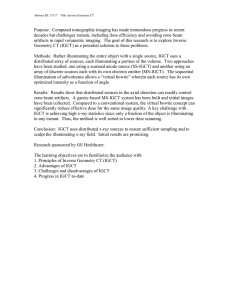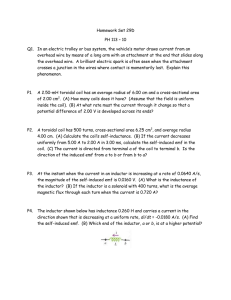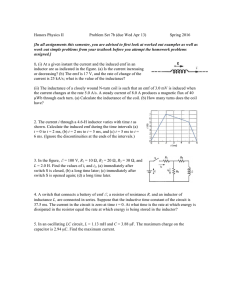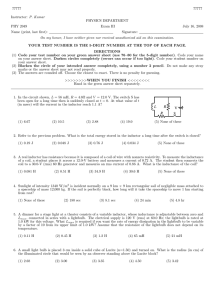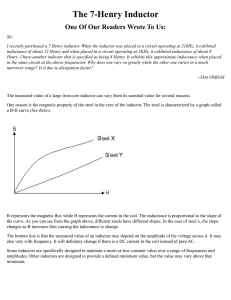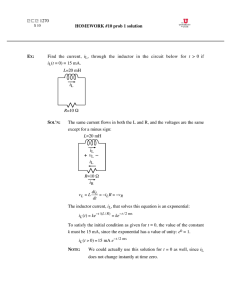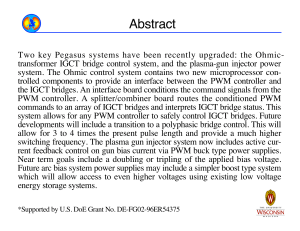How to Fry an IGCT in 1 μs or Less
advertisement
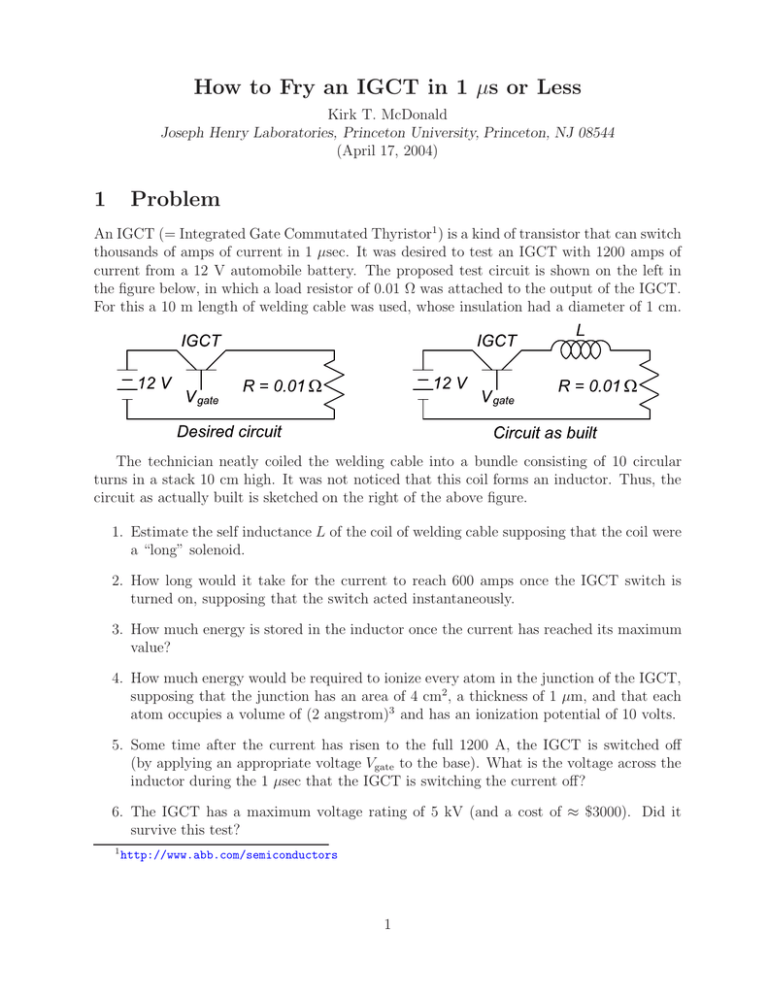
How to Fry an IGCT in 1 μs or Less Kirk T. McDonald Joseph Henry Laboratories, Princeton University, Princeton, NJ 08544 (April 17, 2004) 1 Problem An IGCT (= Integrated Gate Commutated Thyristor1 ) is a kind of transistor that can switch thousands of amps of current in 1 μsec. It was desired to test an IGCT with 1200 amps of current from a 12 V automobile battery. The proposed test circuit is shown on the left in the figure below, in which a load resistor of 0.01 Ω was attached to the output of the IGCT. For this a 10 m length of welding cable was used, whose insulation had a diameter of 1 cm. The technician neatly coiled the welding cable into a bundle consisting of 10 circular turns in a stack 10 cm high. It was not noticed that this coil forms an inductor. Thus, the circuit as actually built is sketched on the right of the above figure. 1. Estimate the self inductance L of the coil of welding cable supposing that the coil were a “long” solenoid. 2. How long would it take for the current to reach 600 amps once the IGCT switch is turned on, supposing that the switch acted instantaneously. 3. How much energy is stored in the inductor once the current has reached its maximum value? 4. How much energy would be required to ionize every atom in the junction of the IGCT, supposing that the junction has an area of 4 cm2, a thickness of 1 μm, and that each atom occupies a volume of (2 angstrom)3 and has an ionization potential of 10 volts. 5. Some time after the current has risen to the full 1200 A, the IGCT is switched off (by applying an appropriate voltage Vgate to the base). What is the voltage across the inductor during the 1 μsec that the IGCT is switching the current off? 6. The IGCT has a maximum voltage rating of 5 kV (and a cost of ≈ $3000). Did it survive this test? 1 http://www.abb.com/semiconductors 1 2 Solution 1. The self inductance L of a coil can be calculated from the magnetic fluxΦ through the coil when it carries current I, according to Φ = LI. (1) Regarding the 10-turn coil as a “long” solenoid of radius r = 10 m /10/2π = 1/2π and length l = 0.1 m, the magnetic field B due to current I is parallel to the axis, essentially uniform inside the coil, and nearly zero outside it. Then, using Ampere’s law for a rectangular loop with one edge parallel to the axis and closer to it than the radius r we have μ NI . (2) and B= 0 Bl = μ0NI, l where N = 10 is the number of turns. The magnetic flux through the coil associated with this field is μ N 2 πr2 I Φ = NBπr2 = 0 , (3) l and hence the self inductance is L= 4π × 10−7 · 102 · π μ0 N 2 πr2 = = 10−4 H. l (2π)2 · 0.1 (4) 2. After the switch is closed, the current in the circuit rises exponentially with time constant τ = L/R = 10−4 /0.01 = 0.01 s. In detail, the circuit equation is Vbattery = L dI + IR, dt (5) whose solution is Vbattery 1 − e−Rt/L , (6) R supposing that the switch was closed at time t = 0. The current reaches one half maximum at time t such that e−Rt/L = 1/2, i.e., when I= t= L ln 2 = 0.007 s. R (7) 3. The energy stored in the inductor is 1 U = LI 2 = 0.5 · 10−4 (1200)2 = 72 Joules. 2 (8) 4. The IGCT junction has a volume of 1 μm · 4 cm2 = 10−6 · 4 · (10−2 )2 = 4 × 10−10 m3. A silicon atom has a volume of (2 angstrom)3 = (2 × 10−10 )3 = 8 × 10−30 m3 . The number of atoms in the junction is 4 × 10−10 /8 × 10−30 = 5 × 1019 . If the ionization potential of silicon is 10 volts, it takes 10 eV = 1.6 × 10−18 Joules of energy to ionize an atom, and hence 5 × 1019 · 1.6 × 10−18 = 80 Joules to ionize every atom in the junction. Thus, the energy stored in the inductor, if applied to ionizing atoms in the junction of the IGCT, would be sufficient to completely ionize the junction. However, even if the junction is only partially ionized it would fail. 2 5. When the IGCT is switched off it forces the current to zero in 1 μsec, so in the present example the rate of change of the current would be dI/ = 1200 A/10−6 s = 1.2 × 109 A/s. The resulting voltage drop across the inductor formed by the welding cable was dI (9) ΔV = L = 10−4 H · 1.2 × 109 A/s = 120, 000 V. dt Note also that ΔV = Vbattery ·τ/10−6 = 10, 000 Vbattery. The IGCT forces the current to change 10,000 times faster than the “natural” time scale of τ = L/R, and consequently a voltage 10,000 times that of the battery is developed across the inductance in the circuit. 6. The 120,000 volts across the inductor also appeared across the IGCT, which is rated for only 5,000 volts. In practice, the IGCT survived for about 1/3 μs, dropping the current from 1200 to 800 amps. It then failed by forming an internal “short” and the current jumped back up to 1200 amps (since very little of the energy stored in the inductor had been dissipated in shorting the IGCT). 3
